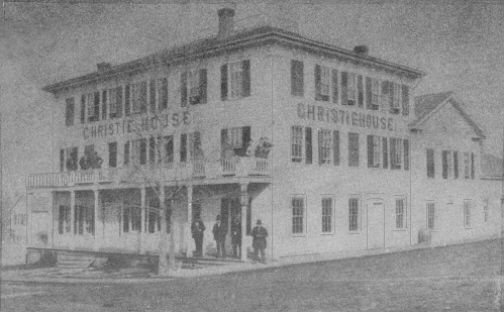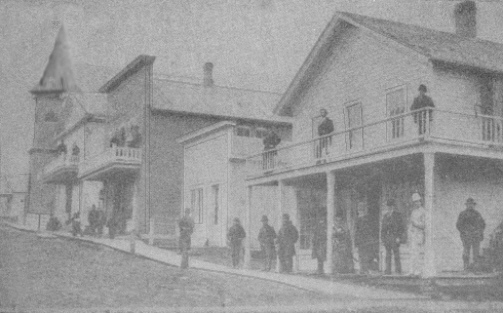Index
of "Good Old Days" Articles
Clark County Press, Neillsville--Transcribed
by Sharon Schulte
August 12, 1998, Page 32
Good Old Days
Main Street Neillsville’s Early Businesses
Starting on the south bank of Hewett Street’s east side, the first building was Eugene Webster’s livery stable. In later years, the livery stable building was moved to the 500 block of Grand Avenue. L.D. Ruddock built a blacksmith shop there, with horse shoeing his specialty.
J.L.Kleckner owned the grist mill on West Main Street for a few years. After selling the grist mill, he with his sons, Alfred and Everett Kleckner, built a feed mill on the former livery stable site, on the east side of Main Street. In the 30’s, the feed mill structure was razed and the American Legion Building was constructed in its place, remaining there now.
The first framed house in Neillsville was built by James O’Neill, Sr., in 1846. It was set on the back of the lot, on the south side of the railroad tracks. The large home occasionally provided room and board for travelers in the early logging era. The O’Neills were very gracious in entertaining and opening up their home to guests on holidays and other special occasions.
Another millinery shop was located in a small building next to the feed mill lot. Mrs. Walker operated the millinery business.
The Al’ Aboard Lunch later was located on the site, which was established by Louie LaBonte. The café facility had been a former railroad passenger car, remodeled into a restaurant. Its unique design and the good food served there is remembered by many. The O’Neill Apartments parking lot is on the former Al’ Aboard site.
Frank Darling’s shoe shop, a wooden structure, was next door. After Darling discontinued his shoe business, the building was remodeled into a tavern. The building is still occupied by a tavern business, the "Rooster Bar".
There were other small wooden buildings with businesses coming and going. A brick building was eventually built next to the tavern and in recent years was known as the Sears Catalog Agency.
Across the alley was another wooden building to be replaced by a brick structure. In 1892, Carl Rabenstein operated an overall factory in the facility. The Equity Garment Co. leased the building in 1925, manufacturing men’s and women’s garments on the main floor with sales and display rooms on the second floor. Later, Warlum and Robinson owned the building for their business.
Next, a small wooden frame building was the business location of Ritz and Haugen Merchant tailors and clothiers. Later, a brick building was erected on the site.
|

The Christie House as it appeared in 1860. Built
by James O'Neill, the hotel carried the name "O'Neill House" during most
of its existence. The hotel's wood exterior was later brick veneered.
Destroyed by fire in 1912, it wasn't rebuilt. The Neillsville Post Office
is now (2004) on the Sixth and Hewett Street corner lot. |
On the site of the present post office building was the
O’Neill House constructed by James O’Neill, the Neillsville pioneer. It was a three-story structure. Built during the period of the Civil War, the hotel was considered "elegant" for that point in time and attracted guests from near and far. It was one of Neillsville’s first businesses to have an electric light above its front door. In 1860, the hotel was leased to a person named Christie and the name was changed to the Christie House. At that time, it had a wood faced exterior, to be brick veneered later. In 1877, O’Neill sold the hotel to James Paulus. John Carkart operated the business in 1882. In its early existence, the hotel served as a comfortable home-away-from-home for on the road salesmen of the day, but also was a focal point for social gatherings of the community. These who wanted to take their families out for a Sunday dinner, enjoyed the cuisine and atmosphere at the hotel’s dining room.
The O’Neill House burned in 1912, and the city later erected a gazebo-style band stand from which the high school band performed its summer concerts. The band shell was torn down in 1937 to make way for the new post office building erected in 1938.
Across Sixth Street, in the 500 block and on the corner, was a wooden building occupied by the Corner Saloon. The business was first managed by Hank Mayers, and later, Ira McIntyre owned the business for a few years. About 1870, James O’Neill established a grocery store in the building, running the business for four years. In 1874, the business was sold to F. Kountz, who operated it for two years, then sold out to Hewett & Woods.
In 1893, the wooden structure was replaced by a two-story brick structure, built by Matt Kappellan. The building’s main floor was finished with an iron and plate glass front. Kappellan was one of the principal owners of the furniture factory. He set up his business in the back portion of his new building, manufacturing fine shoes and boots. The front portion was leased to R.T. Boullion for his business, the Palace Buffet. The building is remembered as the Montgomery Wards Catalog Store location in more recent years and is now vacant.
The next wooden building was a barber shop in 1860, operated by Steve Scharpler and his brothers. In 1874, James O’Neill started the Neillsville Bakery in the structure. Mrs. Tibbett’s restaurant was the next business in the building. She was known as being an excellent cook. The neighboring small wooden building, constructed by Jacob Rossman, the hotel man, was used for a saloon for many years. The two small buildings were razed and was replaced by a brick building, owned by J.B. Lowe. Lowe had a furniture store and preparatory room in the two-story structure until 1939 when a fire leveled the building. A one-story brick building was erected in its place and now provides offices for Ratsch Engineering, Brunner Accounting and Western Erecting.
The next building goes back to pre-1900. It was constructed by Emery Bruley after he gave up the forge and anvil, going into the clothier business. His store was the first to be lighted with gas energy. Two-lighted chandeliers, several bracket burners and four lights in the show window illuminated every portion of the building. A generator, known as the Excelsior Gas Machine powered the system. Bruley’s store was another of the first five businesses to have an electric light to illuminate the area around the front door, starting in 1882.
The next site was occupied by a frame building and was used by James O’Neill, Jr., for his law office. The structure was later given a brick veneer front. An addition built on to the rear of the building was used as a printing office for the Neillsville Times. Zimmerman Bros. owned the building in 1950.
Across the alley, Richard Dewhurst owned the small frame building of the earlier years which he used as a business office. In the 1890’s, he constructed the present brick building on that site, then leased it to his brother-in-aw, D. Dickinson, for a general store. Coffland’s Variety Store occupied the structure in 1893. The Three Rivers Martial Arts is now in the building.
Next, the Thayer building, as known in the mid-1950’s, was constructed by James Ferguson. At the beginning of the century, it was used as a post office, with Ferguson being the postmaster. A candy store and a millinery store had also occupied the structure some time during its early existence. Constant Creations is presently located in the building.
There were two small frame buildings next door, dating back to 1870. One was occupied by a drug store, owned by C.C. Sniteman, and maintained by him in addition to his main drug store across the street. The other of the two buildings was occupied by Anton Unger, who had a shoe store and shoe repair business there until he built a new building on the west side of main street in the 400 block. A brick building was put up on the lot and was known as the Schoengarth Building.
The first brick building on Hewett and Fifth Street’s northeast corner was put up by George L. Lloyd in 1877. Lloyd, a successful lumberman, built the store for a hardware business which he carried on for a number of years. Lloyd, a good businessman, wanted a sturdy structure. He purchased brick made in Milwaukee, had it shipped by rail to Hatfield and hauled by teams and wagons to Neillsville.
In 1893, Balch and Tragsdorf formed a business partnership, having a hardware store in the Lloyd building. Soon after, they built a new brick building on the west side of Hewett Street in the 400 block, moving their business to that location. Cash Hardware Co., owned by Decker, was in the Lloyd building, circa 1900. About 1912, it became the Arne Peterson Hardware Store. The two-story building was later razed and that lot with the adjoining north side lot became the site for a new structure to accommodate the needs of Schultz Bros Variety Store business. Presently, it is the Neillsville Professional Building.
|

An 1878 view from the south-east corner of Fifth and Hewett Streets,
Neillsville. Right to left: B. F. French building where French had his law
office;
Sol Jaseph's
Harness Shop; Geo. Hart's Express Office and the
Presbyterian Church. None of the buildings remain. The gazebo style band
shell currently (2004) stands where the French building was. |
Across the intersection, was the B.F. French building, where French had his law office. Later, Chauncey Blakesley had a general store business in the building.
The wooden two-story building was the site of Frank Hemp’s general store in the early 1900s. It was torn down to provide space for a filling station which also was removed about ten years ago. It is now the site of a recently constructed gazebo-style band shell on the town square.
Next, was The German-American printing office, also a wooden building. Dr. Esch’s first office was in a small wooden structure next door, occupied by him until he built a new brick structure across the street.
The next building and business was a millinery shop run by the Dignin sisters. After the wooden building was long gone, a one-story brick building was erected. At one time, it provided space for the Lewerenz Restaurant. The Lewerenzes were noted for their home-cooking and the delicious home-made ice cream. The name was later changed to the Arbutus Café and it was also the Greyhound Bus Station for several years. The building was torn down in recent years and that lot too, is part of the town square.
Finally, on the corner of Fifth and Hewett was the frame house, residence of
B.F. French, a colorful pioneer and lawyer. French, who came to Clark County in 1855 and the village of Neillsville in 1862, was known as "Doc" French. He had studied medicine and later, law. Although he decided to practice the law profession, he was often called upon for assistance in medical emergencies.
An additional detail mentioned, is that there are or have been a bowling lane or two in the old building basements along Hewett Street. There was a wooden bowling ball left on one of the bowling lanes, a remnant of a popular sport, in the late 1800s.


